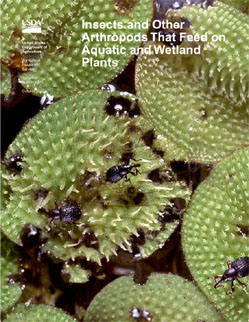This page has been archived and is being provided for reference purposes only. The page is no longer being updated, and therefore, links on the page may be invalid.
|
|
Manual Highlights Arthropods That Curb Aquatic Weeds
By Alfredo FloresJune 24, 2005
A manual developed by the Agricultural Research Service (ARS) and now available online helps scientists, resource managers and others identify biological control insects that play a key role in helping to control aquatic weeds.
The importance of these plant-feeding insects to the dynamics of aquatic and wetland ecosystems is the focus of the new, online reference called "Insects and Other Arthropods That Feed on Aquatic and Wetland Plants." The 200-page manual explains the life cycles of more than 50 of the most common insects and mites found in aquatic environments.
The manual was originally published by ARS scientists at the Invasive Plant Research Laboratory (IPRL) in Fort Lauderdale, Fla., in cooperation with colleagues from the Florida Department of Environmental Protection and the U.S. Army Corps of Engineers. [Editor's note (July 1, 2005): ARS' supply of printed copies of the manual is now exhausted, but web visitors can view or download the online version.]
The IPRL mission is to address the complex, multifaceted problems caused by the invasion of natural and agricultural ecosystems by exotic species. Non-native plants pose some of the most serious threats to the health and integrity of these ecosystems, according to Ted D. Center, IPRL research leader.
Center and other researchers at the lab conduct research to evaluate the impact of exotic plants, as well as the safety and effectiveness of biological control and other methods for managing them. The easy-to-use manual presents data gathered through their work with common native plant-feeding insects and naturalized imported biological control insects. It underscores the importance of these insects in curbing invasive aquatic and wetland weeds.
The manual is organized alphabetically by plant name, from alligatorweed to water-primrose, and the various insects that attack them. Each section includes a history of each insect, its host plants, and its biology and ecology. A special section concentrates on insects with broad diets--those that can't be listed as feeding on just one particular host plant. For example, the red spider mite (Tetranychus tumidus) feeds on plantain, mango, corn, sweet potato and citrus, as well as on water hyacinth. The online version of the IPRL manual is available at:
/is/np/aquaticweeds/aquaticweedsintro.htm
ARS is the U.S. Department of Agriculture's chief scientific research agency.



